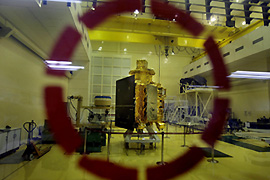India launches first moon mission
Unmanned lunar spacecraft boosts Asian space race with Japan and China.

Chandrayaan-1, with a launch weight of about 1.3 tonnes, is shaped like a cuboid and carries 11 different tools.
Of the 11 instruments, five are Indian, three are from the European Space Agency, two are from the US – including a radar that can search for ice under lunar poles – and one is from Bulgaria.
India hopes to land a rover on the moon in 2011 and eventually launch a manned space programme, though this has not yet been authorised.
Self-reliance
India started its space programme in 1963, developing its own satellites and launch vehicles to reduce dependence on overseas agencies.
Malcolm Walter, a space scientist from the University of New South Wales, Australia, told Al Jazeera that India is aiming to develop its space programme as far as possible.
“Space is no longer a new frontier … It is a field in which they cannot afford not to be involved,” he said.
India, Japan and China see their space programmes as an important symbol of their international stature and economic development as they venture into carving a larger slice of the lucrative commercial satellite launch market.
S Satish, a spokesman from the Indian Space Research Organisation, told Al Jazeera: “Outer space will be the frontier for mankind in the future. So entering [orbiting] the Moon and having an intermediate station is a very significant event.”
Satellite club
India first staked its case for a share of the commercial launch market by sending an Italian satellite into orbit in April of last year.
Then, in January of this year, it launched an Israeli spy satellite, despite protests from Iran.
 |
| The Chandrayaan-1 spacecraft [AFP] |
However, it still has a long way to go to catch up with China which, together with the US, Russia and the European Space Agency, is already well established in the commercial launch sector.
Chinese officials have spoken of a manned mission to the Moon in the future, after following the US and the former Soviet Union last month by carrying out a space walk.
A more immediate goal is the establishment of an orbiting space lab, with Beijing’s long-term ambition to develop a rival to the International Space Station, a joint project involving the US, Russia, Japan, Canada and a clutch of European countries.
Japan has also been boosting its space programme and has set a goal of sending an astronaut to the Moon by 2020.
Conflict in cosmos
As well as the commercial ramifications, the development of a space race in Asia has a number of security implications, with the potential for developing military applications such as intelligence gathering and space-based weapons.
Earlier this year, Japan scrapped a decades-old ban on the military use of space, hoping to remove any legal obstacles to building more advanced spy satellites.
South Korea, a late starter in the space race, has launched three commercial satellites since 1995 and launched its first military communications satellite in 2006.